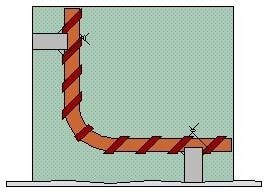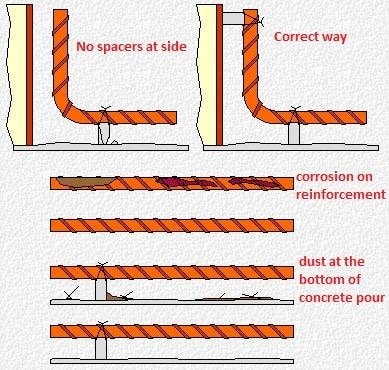Pre-Concrete Checks for Reinforcement and Its Cover
What is Reinforcement Cover? How to Provide Cover to Reinforcement?
It is essential that the steel reinforcement bars are surrounded sufficient impermeable concrete cover to protect them from corrosion, and to allow the combined strength of the reinforcement and concrete to be effective.

From the diagram above, we can see how the process unfolds. When the binding has set, the steel bars are placed into position. The bars are kept the correct distance from the surface by spacers.
When the formwork is erected the concrete can be poured. When the concrete has reached the required strength the formwork can be poured. The cover blocks have ensured that the steel has sufficient protection from the elements.
If the steel had been placed too close to the surface and the concrete had been poured then over time the steel may become exposed to moisture and corrosion will commence.
Spacers can be made from plastic, mortar or steel. Plastic spacers are made to fit particular bar size and give specified depths of cover.
Small mortar blocks are also commonly used which are tied to the reinforcement bars using soft iron binding wire. The ends of these ties should be bent away from the surface of the concrete, otherwise the wire may facilitate the corrosion of the reinforcement.
Steel spacers can be used, but only when the structure is not in a corrosive atmosphere or be exposed to water.
The required amount of cover will always be specified on the design drawings, but no time should the cover be less than the maximum size of aggregate plus 5mm.
Pre-Concrete Checks for Reinforcement and its Cover
The pre-concrete check for reinforcement essentially comes in two parts. The first part is a visual inspection by the clerk of works or equivalent.

Using a steel tape, cover thickness will be checked and any spacers that have fallen off or been broken will need to be replaced.
The clerk or equivalent will be looking to see that the reinforcement bars are free of excessive rust and not covered in mud from foot traffic.
Similarly, the bottom of the concrete pour must be free of debris including the cutoffs from the steel tying bars.
The clerk will also check for under-bent bars that may mail to allow the correct cover and that the bars are at the correct spacing.

In the above fig, left side images shows reinforcement have not been placed correctly. Right side images shows correct way of placing of reinforcement.
The second part is carried out by a surveyor, who will check the steel levels against the required levels from the design drawings. If these levels are satisfactory and the clerk has completed the visual checks then the pour will proceed.
No comments:
Post a Comment